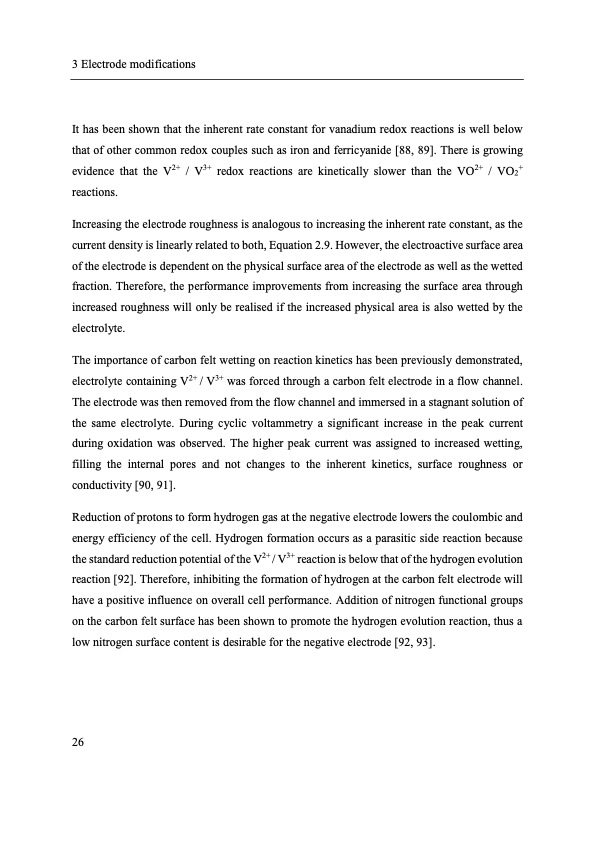
PDF Publication Title:
Text from PDF Page: 038
3 Electrode modifications It has been shown that the inherent rate constant for vanadium redox reactions is well below that of other common redox couples such as iron and ferricyanide [88, 89]. There is growing evidence that the V2+ / V3+ redox reactions are kinetically slower than the VO2+ / VO2+ reactions. Increasing the electrode roughness is analogous to increasing the inherent rate constant, as the current density is linearly related to both, Equation 2.9. However, the electroactive surface area of the electrode is dependent on the physical surface area of the electrode as well as the wetted fraction. Therefore, the performance improvements from increasing the surface area through increased roughness will only be realised if the increased physical area is also wetted by the electrolyte. The importance of carbon felt wetting on reaction kinetics has been previously demonstrated, electrolyte containing V2+ / V3+ was forced through a carbon felt electrode in a flow channel. The electrode was then removed from the flow channel and immersed in a stagnant solution of the same electrolyte. During cyclic voltammetry a significant increase in the peak current during oxidation was observed. The higher peak current was assigned to increased wetting, filling the internal pores and not changes to the inherent kinetics, surface roughness or conductivity [90, 91]. Reduction of protons to form hydrogen gas at the negative electrode lowers the coulombic and energy efficiency of the cell. Hydrogen formation occurs as a parasitic side reaction because the standard reduction potential of the V2+ / V3+ reaction is below that of the hydrogen evolution reaction [92]. Therefore, inhibiting the formation of hydrogen at the carbon felt electrode will have a positive influence on overall cell performance. Addition of nitrogen functional groups on the carbon felt surface has been shown to promote the hydrogen evolution reaction, thus a low nitrogen surface content is desirable for the negative electrode [92, 93]. 26PDF Image | Electron Transfer Kinetics in Redox Flow Batteries

PDF Search Title:
Electron Transfer Kinetics in Redox Flow BatteriesOriginal File Name Searched:
electron-transfer-flow-batteries-thesis.pdfDIY PDF Search: Google It | Yahoo | Bing
Salgenx Redox Flow Battery Technology: Salt water flow battery technology with low cost and great energy density that can be used for power storage and thermal storage. Let us de-risk your production using our license. Our aqueous flow battery is less cost than Tesla Megapack and available faster. Redox flow battery. No membrane needed like with Vanadium, or Bromine. Salgenx flow battery
| CONTACT TEL: 608-238-6001 Email: greg@salgenx.com | RSS | AMP |